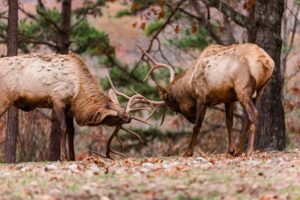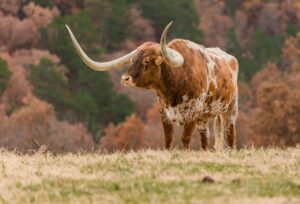Antlers vs. Horns: Key Differences in Nature’s Headgear

Published September 18, 2024
Across the vast and diverse North American landscape, you’ll find majestic bighorn sheep, graceful mule deer, powerful bison, regal elk and towering moose. These iconic animals are easily recognizable by their impressive antlers or horns. Interestingly, people often use the terms “antlers” and “horns” interchangeably, though they are quite different in their characteristics.
Antlered ungulates, such as elk, moose, mule deer, white-tailed deer, and caribou, rely on their antlers to impress females and serve as weapons for males during the breeding season, known as the “rut.”
Antlers undergo a fascinating process called ossification, where cartilage calcifies into bone following a hormone change. Covered in a layer of fine hairs that resemble velvet, the velvet-like casing provides blood supply to the growing tissue. Remarkably, antlers can grow up to an inch a day, making them the fastest-growing animal tissue in the world!

As the breeding season approaches, the velvet begins to dry, causing an itchy sensation for these animals. They rub their antlers against vegetation and tree bark to relieve the itch and remove the velvet. Though this process may appear gruesome, it is entirely safe and beneficial for these magnificent creatures.
After the rut, typically in late winter through early spring, antlers begin to shed. As daylight decreases during the winter months, males experience a drop in testosterone, weakening the connection between the antlers and the skull. To conserve energy for foraging, they shed their heavy head ornaments and people consider shed hunting a fun outdoor hobby.
Horns, on the other hand, are a permanent feature that grows with the animal throughout its life. Made of bone and covered in keratin – a protein found in our hair, skin, and nails – provides both strength and flexibility. However, if a horn is broken or damaged, it will remain that way forever.
In North America, horned species include bighorn sheep, bison, and cattle. These animals use their horns to establish dominance during mating competitions. The continuous growth of horns results in impressive sizes that may grab the attention of females.

Despite their differences, both antlers and horns offer protection and benefits to their ecosystems. As herbivores, these animals rely on their head ornaments for defense against predators, as they lack sharp teeth and claws. The sharp points of a white-tailed deer’s antlers and the sheer force from a ramming sheep are formidable deterrents.
Even after an animal’s death, their antlers and horns continue to serve a purpose. These structures, rich in nutrients like calcium, phosphorus, and protein, provide essential nutrition for bears, foxes, opossums, and otters. Mice, squirrels, and rabbits enjoy gnawing on them to help wear down their ever-growing teeth.

During the autumn and early winter seasons, guests can witness the splendor of Dogwood Canyon’s very own mighty ungulates, including bison, majestic elk, and iconic Texas longhorn. Our tram tours offer an exclusive opportunity to witness breathtaking nature and wildlife that surrounds us daily. Visit us to learn more about the beauty of our sister property, Dogwood Canyon, and the animals that call this region home.
News & Updates
Read the latest news & updates about Wonders of Wildlife.
